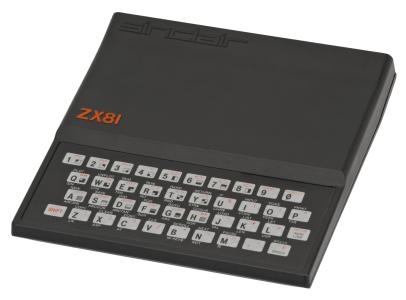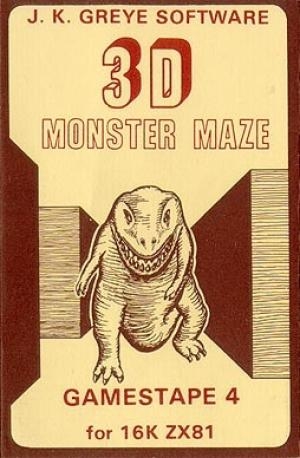
Sinclair ZX81
Sinclair ZX81 Specifications
| Manufacturer: | Timex Corporation |
| Developer: | Sinclair Research |
| CPU: | Z80 @ 3.25 MHz |
| Memory: | 1 KB (64 KB max. 56 KB usable) |
| Graphics: | 24 lines × 32 characters or 64 × 48 pixels graphics mode |
| Medium: | Cassette tape |
| Display: | Monochrome display on UHF television |
The Sinclair ZX81 is a home computer that was released in the United Kingdom in 1981 by Sinclair Research Ltd. It was designed to be an affordable personal computer for the masses, and was one of the first computers to break the $100 price barrier. The ZX81 had a minimalist design, with only 1 KB of RAM and no color graphics or sound capabilities. However, it was still capable of running BASIC programs and could be expanded with additional memory and peripherals. The ZX81 was popular among hobbyists and enthusiasts, and sold over 1.5 million units before it was discontinued in 1984. It is often considered a classic example of early home computing technology.
The ZX81 was designed to be small, simple, and above all, inexpensive, with as few components as possible. Video output is to a television set rather than a dedicated monitor. Programs and data are loaded and saved onto compact audio cassettes. It uses only four silicon chips and 1 KB of memory. It has no power switch or moving parts, with the exception of a VHF TV channel selector switch present in some models. It has a pressure-sensitive membrane keyboard. The ZX81's limitations prompted a market in third-party peripherals to improve its capabilities. Its distinctive case and keyboard brought designer Rick Dickinson a Design Council award.
The ZX81 could be bought by mail order preassembled or, for a lower price, in kit form. It was the first inexpensive mass-market home computer to be sold by high street stores, led by W. H. Smith and soon many other retailers. The ZX81 marked the point when computing in Britain became an activity for the general public rather than the preserve of businessmen and electronics hobbyists. It produced a huge community of enthusiasts, some of whom founded their own businesses producing software and hardware for the ZX81. Many went on to have roles in the British computer industry. The ZX81's commercial success made Sinclair Research one of Britain's leading computer manufacturers and earned a fortune and an eventual knighthood for the company's founder, Sir Clive Sinclair.
The ZX81 has a base configuration of 1 KB of on-board memory that can officially be expanded externally to 16 KB. Its single circuit board is housed inside a wedge-shaped plastic case measuring 167 millimetres (6.6 in) wide by 40 millimetres (1.6 in) high. The memory is provided by either a single 4118 (1024 bit × 8) or two 2114 (1024 bit × 4) RAM chips. There are only three other onboard chips: a 3.5 MHz Z80A 8-bit microprocessor from NEC, an uncommitted logic array (ULA) chip from Ferranti, and an 8 KB ROM providing a simple Sinclair BASIC interpreter. The entire machine weighs just 350 grams (12 oz). Early versions of the external RAM cartridge contain 15 KB of memory using an assortment of memory chips, while later versions contain 16 KB chips with the lowest addressed kilobyte disabled.
The front part of the case is occupied by an integrated 40-key membrane keyboard. The keyboard is mechanically very simple, consisting of 40 pressure-pad switches and 8 diodes under a plastic overlay, connected in a matrix of 8 rows and 5 columns.
The ZX81 uses a standard QWERTY keyboard layout displaying 20 graphic and 54 inverse video characters. However ZX81 BASIC commands are not typed in letter by letter, instead each key has up to five key functions. This is how the user displays the ZX81's BASIC keywords, functions, mathematical operations and graphics.
The ZX81 key's function is determined by a combination of context in the command and mode selection e.g. SHIFT and FUNCTION keys to select the red keyboard functions. For example, the P key combines the letter P, the " character, and the BASIC commands PRINT and TAB.
The fact that to effect a RUBOUT or backspace/delete operation took 3 key presses encouraged ZX81 programmers to be brief and type carefully when entering text or code.
The ZX81's primary input/output is delivered via four sockets on the left side of the case. The machine uses an ordinary UHF television set to deliver a monochrome picture via a built-in RF modulator. It can display 24 lines of 32 characters each, and by using the selection of 2×2 block character graphics from the machine's character set offers an effective 64 × 44 pixel graphics mode, also directly addressable via BASIC using the PLOT and UNPLOT commands, leaving 2 lines free at the bottom. Two 3.5 mm jacks connect the ZX81 to the EAR (output) and MIC (input) sockets of an audio cassette recorder, enabling data to be saved or loaded. This stores each data bit as a number of pulses followed by an inter-bit silence of 1300 µs. Each pulse is a 150 µs 'high' then a 150 µs 'low'. A '0' bit consists of four pulses while a '1' bit is nine pulses, so the baud rate varies between 400 bit/s for all '0's and 250 bit/s for all '1's. A file with equal amounts of '0's and '1's would be stored at 307 bit/s (38 B/s). This provides a somewhat temperamental storage medium for the machine, which has no built-in storage capabilities. The ZX81 requires 420 mA of current at 7–11 V DC, delivered via a custom 9 V Sinclair DC power supply.
The ZX81's built-in RF modulator can output a video picture to a UHF 625-line television (used in the UK, Australia, and most western European countries). France and Luxembourg required a slightly modified version of the machine to match the positive video modulation of CCIR System L sets, while the United States and Canada required a different ULA chip and modulator to cope with their 525-line VHF (NTSC) television systems. Both the ZX81 and its predecessor, the ZX80, have a significant drawback in the way that they handle visual output. Neither machine has enough processing power to run at full speed and simultaneously maintain the screen display. On the ZX80, this means that the screen goes blank every time the machine carries out a computation and causes an irritating flicker whenever a shorter computation – such as processing a keystroke – takes place.
The ZX81's designers adopted an improved approach, involving the use of two modes called SLOW and FAST respectively. In SLOW mode, also called "compute and display" mode, the ZX81 concentrates on driving the display. It runs the current program for only about a quarter of the time – in effect slowing the machine down fourfold, although in practice the speed difference between FAST and SLOW modes depends on what computation is being done. In FAST mode, processing occurs continuously, but the display is abandoned to its own devices – equivalent to the ZX80's standard operating mode.
Another hardware quirk produced one of the most distinctive aspects of the ZX81's screen display – during loading or saving, moving zigzag stripes appear across the screen. The same pin on the ULA is used to handle the video signal and the tape output, producing the stripes as an interference pattern of sorts. The ULA cannot maintain the display during SAVE and LOAD operations, as it has to operate continuously to maintain the correct baud rate for data transfers. The interference produces the zigzag stripes.
The unexpanded ZX81's tiny memory presents a major challenge to programmers. Simply displaying a full screen takes up to 793 bytes, the system variables take up another 125 bytes, and the program, input buffer and stacks need more memory on top of that. Nonetheless, ingenious programmers are able to achieve a surprising amount with just 1 KB. One example is the Super Micro Chess Engine by Stefano Maragò, which includes all of the rules of chess. The ZX81 conserves its memory to a certain extent by representing entire BASIC commands as one-byte tokens, stored as individual "characters" in the upper reaches of the machine's unique (non-ASCII) character set.
The edge connector or external interface at the rear of the ZX81 is an extension of the main printed circuit board. This provides a set of address, control, and data lines that can be used to communicate with external devices. Enthusiasts and a variety of third-party companies make use of this facility to create a wide range of add-ons for the ZX81.
Latest on Sinclair ZX81

3D Monster Maze
3D Monster Maze is a survival horror computer game developed from an idea by J.K. Greye and programmed by Malcolm Evans and released in 1981 for the S...